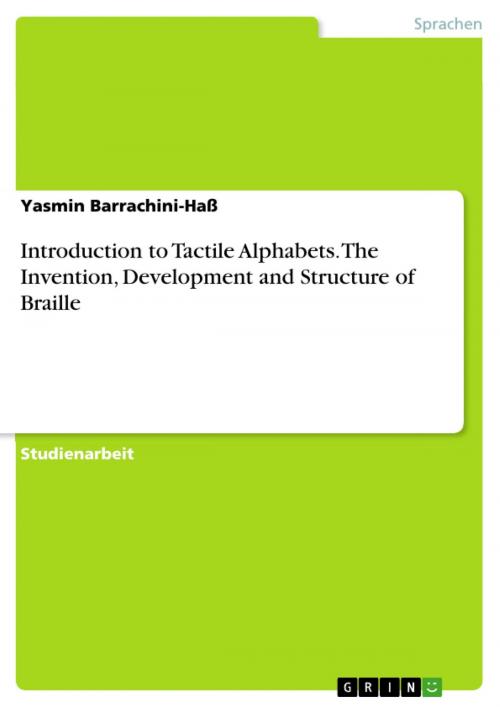Introduction to Tactile Alphabets. The Invention, Development and Structure of Braille
Nonfiction, Reference & Language, Language Arts, Linguistics| Author: | Yasmin Barrachini-Haß | ISBN: | 9783668197213 |
| Publisher: | GRIN Verlag | Publication: | April 14, 2016 |
| Imprint: | GRIN Verlag | Language: | German |
| Author: | Yasmin Barrachini-Haß |
| ISBN: | 9783668197213 |
| Publisher: | GRIN Verlag |
| Publication: | April 14, 2016 |
| Imprint: | GRIN Verlag |
| Language: | German |
Studienarbeit aus dem Jahr 2012 im Fachbereich Sprachwissenschaft / Sprachforschung (fachübergreifend), Note: 1,7, Universität Bremen (Fachbereich Sprach- und Literaturwissenschaften), Veranstaltung: Schriftsysteme- Typologie und Geschichte, Sprache: Deutsch, Abstract: This term paper focuses mainly on the characteristics of Braille which are relevant from a linguistic point of view, but also discusses historical events of how Louis Braille invented the aforesaid writing system, as well as how the aforesaid writing system evolved over the past 187 years. It must also be said that this term paper focuses mainly on American English Braille (AEB), because this particular writing system is widely used, well documented, and has evolved faster than any other tactile writing system. However, other types of Braille are occasionally mentioned in this paper, too. Braille is a writing system that is mostly used by blind people or people who suffer from significant vision loss. However, individuals who are not visually impaired can also read it by using their eyesight. A special feature about Braille is that it can be read by using just one's finger tips. The first chapter deals with tactile alphabets in general. Since Braille is just one type of many existing tactile alphabets, this chapter clarifies its definition and variations. There are two different types of tactile alphabets. One is based on embossed Roman letters, and the second type of tactile alphabet is based on arbitrary symbols. Each type is further explained in a subchapter. The second chapter is about the invention and development of Braille. This chapter focuses, among other things, on the life of Braille, how he became blind and created his own writing system that evolved to be the most important reading and writing tool to many blind communities all over the world. In subchapter 2.2, it is also explained how Braille derived from an already existing tactile alphabet called night writing, and how this aforesaid writing system is structured. The third chapter discusses linguistic features and structures of Braille. The arrangement of AEB is discussed, as well as the difference between Grade 1 Braille and Grade 2 Braille. Moreover, the third chapter discusses how Braille can be used alternatively for all other writing systems, which, among other things, do not resemble the Latin alphabet, and how that leads eventually to different variations of Braille. Finally, the Unified English Braille (UEB) code is also included as a topic in the third chapter. The aforesaid chapter is followed by a conclusion, a list of references and a declaration of authenticity.
Studienarbeit aus dem Jahr 2012 im Fachbereich Sprachwissenschaft / Sprachforschung (fachübergreifend), Note: 1,7, Universität Bremen (Fachbereich Sprach- und Literaturwissenschaften), Veranstaltung: Schriftsysteme- Typologie und Geschichte, Sprache: Deutsch, Abstract: This term paper focuses mainly on the characteristics of Braille which are relevant from a linguistic point of view, but also discusses historical events of how Louis Braille invented the aforesaid writing system, as well as how the aforesaid writing system evolved over the past 187 years. It must also be said that this term paper focuses mainly on American English Braille (AEB), because this particular writing system is widely used, well documented, and has evolved faster than any other tactile writing system. However, other types of Braille are occasionally mentioned in this paper, too. Braille is a writing system that is mostly used by blind people or people who suffer from significant vision loss. However, individuals who are not visually impaired can also read it by using their eyesight. A special feature about Braille is that it can be read by using just one's finger tips. The first chapter deals with tactile alphabets in general. Since Braille is just one type of many existing tactile alphabets, this chapter clarifies its definition and variations. There are two different types of tactile alphabets. One is based on embossed Roman letters, and the second type of tactile alphabet is based on arbitrary symbols. Each type is further explained in a subchapter. The second chapter is about the invention and development of Braille. This chapter focuses, among other things, on the life of Braille, how he became blind and created his own writing system that evolved to be the most important reading and writing tool to many blind communities all over the world. In subchapter 2.2, it is also explained how Braille derived from an already existing tactile alphabet called night writing, and how this aforesaid writing system is structured. The third chapter discusses linguistic features and structures of Braille. The arrangement of AEB is discussed, as well as the difference between Grade 1 Braille and Grade 2 Braille. Moreover, the third chapter discusses how Braille can be used alternatively for all other writing systems, which, among other things, do not resemble the Latin alphabet, and how that leads eventually to different variations of Braille. Finally, the Unified English Braille (UEB) code is also included as a topic in the third chapter. The aforesaid chapter is followed by a conclusion, a list of references and a declaration of authenticity.















